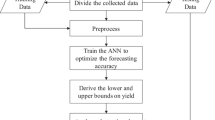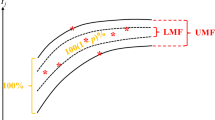Abstract
Accurately forecasting the book-to-bill (BB) ratio is critical to the semiconductor manufacturing industry. Therefore, a hybrid fuzzy linear regression and back-propagation network (BPN) approach is proposed in this study. In the proposed approach, multiple experts construct their own fuzzy multiple linear regression models from various viewpoints to forecast the future BB ratio. Each fuzzy multiple linear regression model can be converted into two equivalent nonlinear programming problems to be solved. To aggregate these fuzzy BB ratio forecasts, a two-step aggregation mechanism is applied. At the first step, a fuzzy intersection is applied to aggregate the fuzzy BB ratio forecasts into a polygon-shaped fuzzy number, in order to improve the precision. After that, a back-propagation network is constructed to defuzzify the polygon-shaped fuzzy number and to generate a representative/crisp value, so as to enhance the accuracy. The practical case of equipment manufacturers with their headquarters in North America is used to evaluate the effectiveness of the proposed methodology. According to the experimental results, the proposed methodology improved both the precision and accuracy of the BB ratio forecasting by 21% and 81%, respectively.
Similar content being viewed by others
References
Yeh T, Chen HW (2006) Constructing a new leading index for Taiwan. Taiwan Economic Forum 4(12):11–36
SEMI (2008) Historical book-to-bill reports (1991–2007). http://www.the-infoshop.com/report/sem64463-book-to-bill.html
Gao J-J, Wang Y-J, Hu L-J (2006) Modeling and simulating for a distribution system based on fuzzy systems to forecast demand. In: Proceedings of IEEE International Conference on Service Operations and Logistics, and Informatics, pp 382–387
Tozan H, Vayvay O (2008) Fuzzy forecasting applications on supply chains. WSEAS Trans Syst 7(5):600–609
Efendigil T, Onüt S, Kahraman C (2009) A decision support system for demand forecasting with artificial neural networks and neuro-fuzzy models: a comparative analysis. Expert Syst Appl 36(3):6697–6707
Liu H, Deng T, Zhang H (2009) Research on forecasting method of urban water demand based on fuzzy theory. Proceedings of International Conference on Fuzzy Systems and Knowledge Discovery 6:389–395
Xie Y (2009) The influences of fuzzy demand forecast on bullwhip effect in a serial supply chain. In: Proceedings of IEEE International Conference on Industrial Engineering and Engineering Management, pp 1424–1428
Kao C, Hsu W-K (2002) A single-period inventory model with fuzzy demand. Comput Math Appl 43(6–7):841–848
Guan Z-M, Zhou B-G (2006) The optimization model for order quantity allocation with fuzzy demand and price discount. In: Proceedings of 2006 International Conference on Management Science and Engineering, pp 397–401
Dai Y (2008) Inventory model with fuzzy demand during lead time. J Southwest Jiaotong Univ 43(4):514–518
Chen CY, Lin JW, Lee WI, Chen CW (2010) Fuzzy control for an oceanic structure: a case study in time-delay TLP system. J Vib Control 16(1):147–160
D’Urso P (2003) Linear regression analysis for fuzzy/crisp input and fuzzy/crisp output data. Comput Stat Data Anal 42:47–72
Tanaka H, Watada J (1988) Possibilistic linear systems and their application to the linear regression model. Fuzzy Sets Syst 272:275–289
Chen T (2007) Evaluating the mid-term competitiveness of a product in a semiconductor fabrication factory with a systematic procedure. Comput Ind Eng 53:499–513
Peters G (1994) Fuzzy linear regression with fuzzy intervals. Fuzzy Sets Syst 63:45–55
Redden DT, Woodall WH (1994) Properties of certain fuzzy linear regression methods. Fuzzy Sets Syst 64:361–375
Donoso S, Marin N, Vila MA (2006) Quadratic programming models for fuzzy regression. In: Proceedings of International Conference on Mathematical and Statistical Modeling in Honor of Enrique Castillo
Bárdossy A (1990) Note on fuzzy regression. Fuzzy Sets Syst 65:65–75
Diamond P (1988) Fuzzy least squares. Inf Sci 46:141–157
Tanaka H, Lee H (1998) Interval regression analysis by quadratic programming approach. IEEE Trans Fuzzy Syst 6(4):473–481
Hsiao FH, Xu SD, Lin CY, Tsai ZR (2008) Robustness design of fuzzy control for nonlinear multiple time-delay large-scale systems via neural-network-based approach. IEEE Trans Syst Man Cybern B Cybern 38(1):244–251
Chen CW (2009) Modeling and control for nonlinear structural systems via a NN-based approach. Expert Syst Appl 36(3):4765–4772
Piramuthu S (1991) Theory and methodology—financial credit-risk evaluation with neural and neural fuzzy systems. Eur J Oper Res 112:310–321
Chang P-C, Hsieh J-C, Liao TW (2005) Evolving fuzzy rules for due-date assignment problem in semiconductor manufacturing factory. J Intell Manuf 16:549–557
Chang P-C, Hsieh J-C (2003) A neural networks approach for due-date assignment in a wafer fabrication factory. Int J Ind Eng 10(1):55–61
Li Q, Xu M, Zhang H, Liu F (2005) Neural network based flow forecast and diagnosis. Lect Notes Comput Sci 3802:542–547
Al-Deek HM (2007) Use of vessel freight data to forecast heavy truck movements at seaports. Transportation Research Record: Journal of the Transportation Research Board 1804:217–224
Chen T, Lin YC (2008) A fuzzy-neural system incorporating unequally important expert opinions for semiconductor yield forecasting. International Journal of Uncertainty, Fuzziness, and Knowledge-based Systems 16(1):35–58
Chen T (2009) A fuzzy-neural knowledge-based system for job completion time prediction and internal due date assignment in a wafer fabrication plant. Int J Syst Sci 40(8):889–902
Huang D, Chen T, Wang MJJ (2001) A fuzzy set approach for event tree analysis. Fuzzy Sets Syst 118:153–165
Chen T (2003) A fuzzy back propagation network for output time prediction in a wafer fab. Appl Soft Comput 2(3):211–222
Abramowitz M, Stegun IA (1972) Handbook of mathematical functions with formulas, graphs, and mathematical tables. Dover, New York
Cheng IS, Tsujimura Y, Gen M, Tozawa T (1995) An efficient approach for large scale project planning based on fuzzy Delphi method. Fuzzy Sets Syst 76:277–288
Kaufmann A, Gupta MM (1998) Fuzzy mathematical models in engineering and management science. North-Holland, Amsterdam
Chen T (2008) A fuzzy-neural approach for estimating the monthly output of a semiconductor manufacturing factory. Int J Adv Manuf Technol 39(5–6):589–598
Chen T, Wang YC, Wu HC (2009) A fuzzy-neural approach for remaining cycle time estimation in a semiconductor manufacturing factory—a simulation study. Int J Innovat Comput Inf Control 5(8):2125–2139
Chen T, Wu H-C, Wang Y-C (2009) Fuzzy-neural approaches with example post-classification for estimating job cycle time in a wafer fab. Appl Soft Comput 9:1225–1231
Chen T, Wang YC, Tsai HR (2009) Lot cycle time prediction in a ramping-up semiconductor manufacturing factory with a SOM-FBPN-ensemble approach with multiple buckets and partial normalization. Int J Adv Manuf Technol 42(11–12):1206–1216
Chen T (2008) A SOM-FBPN-ensemble approach with error feedback to adjust classification for wafer-lot completion time prediction. Int J Adv Manuf Technol 37(7–8):782–792
Chen T, Wang YC (2009) A nonlinear scheduling rule incorporating fuzzy-neural remaining cycle time estimator for scheduling a semiconductor manufacturing factory. Int J Adv Manuf Technol 45:110–121
Liu X (2007) Parameterized defuzzification with maximum entropy weighting function—another view of the weighting function expectation method. Math Comput Model 45:177–188
Author information
Authors and Affiliations
Corresponding author
Rights and permissions
About this article
Cite this article
Chen, T., Wang, YC. A hybrid fuzzy and neural approach for forecasting the book-to-bill ratio in the semiconductor manufacturing industry. Int J Adv Manuf Technol 52, 377–389 (2011). https://doi.org/10.1007/s00170-010-2712-5
Received:
Accepted:
Published:
Issue Date:
DOI: https://doi.org/10.1007/s00170-010-2712-5




